|
|
|
Sort Order |
|
|
|
Items / Page
|
|
|
|
|
|
|
| Srl | Item |
| 1 |
ID:
092839


|
|
|
|
|
| Publication |
2009.
|
| Summary/Abstract |
This paper investigates the potential for making deep cuts in US transportation greenhouse gas (GHG) emissions in the long-term (50-80% below 1990 levels by 2050). Scenarios are used to envision how such a significant decarbonization might be achieved through the application of advanced vehicle technologies and fuels, and various options for behavioral change. A Kaya framework that decomposes GHG emissions into the product of four major drivers is used to analyze emissions and mitigation options. In contrast to most previous studies, a relatively simple, easily adaptable modeling methodology is used which can incorporate insights from other modeling studies and organize them in a way that is easy for policymakers to understand. Also, a wider range of transportation subsectors is considered here-light- and heavy-duty vehicles, aviation, rail, marine, agriculture, off-road, and construction. This analysis investigates scenarios with multiple options (increased efficiency, lower-carbon fuels, and travel demand management) across the various subsectors and confirms the notion that there are no "silver bullet" strategies for making deep cuts in transport GHGs. If substantial emission reductions are to be made, considerable action is needed on all fronts, and no subsectors can be ignored. Light-duty vehicles offer the greatest potential for emission reductions; however, while deep reductions in other subsectors are also possible, there are more limitations in the types of fuels and propulsion systems that can be used. In all cases travel demand management strategies are critical; deep emission cuts will not likely be possible without slowing growth in travel demand across all modes. Even though these scenarios represent only a small subset of the potential futures in which deep reductions might be achieved, they provide a sense of the magnitude of changes required in our transportation system and the need for early and aggressive action if long-term targets are to be met.
|
|
|
|
|
|
|
|
|
|
|
|
|
|
|
|
| 2 |
ID:
170880


|
|
|
| 3 |
ID:
097432


|
|
|
|
|
| Publication |
2010.
|
| Summary/Abstract |
Hotel buildings are reported in many countries as one of the most energy intensive building sectors. Besides the pressure posed on energy supply, they also have adverse impact on the environment through greenhouse gas emissions, wastewater discharge and so on. This study was intended to shed some light on the energy and environment related issues in hotel industry. Energy consumption data and relevant information collected from hotels were subjected to rigorous statistical analysis. A regression-based benchmarking model was established, which takes into account, the difference in functional and operational features when hotels are compared with regard to their energy performance. In addition, CO2 emissions from the surveyed hotels were estimated based on a standard procedure for corporate GHG emission accounting. It was found that a hotel's carbon intensity ranking is rather sensitive to the normalizing denominator chosen. Therefore, carbon intensity estimated for the hotels must not be interpreted arbitrarily, and industry specific normalizing denominator should be sought in future studies.
|
|
|
|
|
|
|
|
|
|
|
|
|
|
|
|
| 4 |
ID:
167024
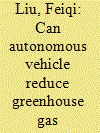

|
|
|
|
|
| Summary/Abstract |
Autonomous vehicles are believed to be the next-generation technology for future societies. The energy and environmental impacts of autonomous vehicles have been realized to be important issues, but quantitative analysis is lacking. In this study, by using China's passenger vehicle fleet as an example, we evaluate the effects of autonomous vehicle deployment on greenhouse gas emissions in different scenarios of autonomous vehicle penetration rates and fuel consumption changes. A comprehensive literature review is conducted to support the study. Autonomous vehicles are found to potentially affect the total greenhouse gas emissions in multiple ways, including reducing vehicle ownership, increasing vehicle use intensity, and changing the vehicle fuel consumption rate. These impacts are mostly internally offset such that the overall impact of autonomous vehicle deployment on greenhouse gas emissions is not significant in the near-to mid-term. With a higher autonomous vehicle penetration rate achieved, in the optimistic scenario, a net reduction in greenhouse gas emissions is expected to be realized. In addition, the fuel economy levels of autonomous vehicles are highly uncertain and cause major uncertainties in the simulation results. More field tests and evidence are needed to improve the evaluation reliability.
|
|
|
|
|
|
|
|
|
|
|
|
|
|
|
|
| 5 |
ID:
117220
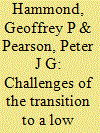

|
|
|
|
|
| Publication |
2013.
|
| Summary/Abstract |
Electricity generation presently contributes approximately 30% of United Kingdom (UK) carbon dioxide (CO2) emissions (Alderson et al., 2012 and Parliamentary, 2007), the principal 'greenhouse gas' (GHG) having an atmospheric residence time of about 100 years (Hammond, 2000). This share mainly arises from the use of fossil fuel (coal and natural gas) combustion for this purpose. Changes in atmospheric concentrations of GHGs affect the energy balance of the global climate system. Human activities have led to quite dramatic increases since 1950 in the 'basket' of GHGs incorporated in the Kyoto Protocol; concentrations have risen from 330 ppm to about 430 ppm currently (IPCC, 2007). Prior to the first industrial revolution in the 18th Century the atmospheric concentration of 'Kyoto gases' was only some 270 ppm. The cause of the observed rise in global average near-surface temperatures over the second half of the 20th Century has been a matter of dispute and controversy. But the most recent (2007) scientific assessment by the Intergovernmental Panel on Climate Change (IPCC) states with 'very high confidence' that humans are having a significant impact on the global warming (IPCC, 2007). They argue that GHG emissions from human activities trap long-wave thermal radiation from the Earth's surface in the atmosphere (not strictly 'greenhouse' phenomena), and that these are the main cause of rises in climatic temperatures. In order to mitigate anthropogenic climate change, the Royal Commission on Environmental Pollution in the UK (RCEP, 2000) recommended at the turn of the Millennium a 60% cut in UK CO2 emissions by 2050. The British Government subsequently set a tougher, legally binding target of reducing the nation's CO2 emissions overall by 80% by 2050 in comparison to a 1990 baseline ( Department of Trade and Industry [DTI], 2007 and Climate, 2008).
|
|
|
|
|
|
|
|
|
|
|
|
|
|
|
|
| 6 |
ID:
094911


|
|
|
|
|
| Publication |
2010.
|
| Summary/Abstract |
Local governments can have a large effect on carbon emissions through land use zoning, building codes, transport infrastructure investments, and support for transportation alternatives. This paper proposes a climate policy instrument - city carbon budgets - that provides a durable framework for local governments to reduce greenhouse gas emissions. Local governments would be assigned an emissions "budget", and would be required to keep annual local transport and buildings emissions within this budget. This policy framework could be implemented and managed by a higher-level government, or might be used in awarding funds to developing country cities from international climate funds. The state of California has enacted a version of this policy. In this paper, we identify and evaluate options for creating an effective and acceptable institutional structure, allocating emission targets to localities, measuring emissions, providing flexibility and incentives to local governments, and assuring compliance. We also discuss the likely costs of such a policy.
|
|
|
|
|
|
|
|
|
|
|
|
|
|
|
|
| 7 |
ID:
127518
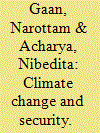

|
|
|
| 8 |
ID:
113478
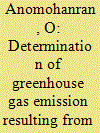

|
|
|
|
|
| Publication |
2012.
|
| Summary/Abstract |
Greenhouse gas emission and its effect on the environment have gained the attention of researchers, environmentalists and policy makers in recent times. This is as a result of its devastating impact both on the climate and the environment. Records of natural gas produced and natural gas flared in Nigeria from 1999 to 2009 were collected and subjected to descriptive analysis as well as the Reference Approach method of greenhouse gas determination. Result showed that the total gas produced in Nigeria from 1999 to 2009 was 502 million cubic meters while 237 million cubic meters, representing 47% was flared. Result also showed that the total gas flared reduced from 23 million cubic meters in 1999 to 14 million cubic meters in 2009. Result indicates that the total quantity of carbon dioxide emitted between 1999 and 2009 was found to be 457 million metric tons which is 23.1 percent when compared with the global value of 1979 million metric tons. Result further indicates that an estimated sum of 11 billion dollars is lost annually to gas flaring in Nigeria. It is recommended that the government should put in place appropriate and implementable policies to end gas flaring in Nigeria.
|
|
|
|
|
|
|
|
|
|
|
|
|
|
|
|
| 9 |
ID:
109425
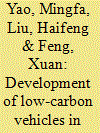

|
|
|
|
|
| Publication |
2011.
|
| Summary/Abstract |
Reducing CO2 emissions from vehicles in China is crucial and will significantly alleviate the environmental burden of the Earth. Some promising technologies that make possible low-carbon vehicles are reviewed in this work, including electric vehicles, fuel cell vehicles, hybrid vehicles, biofuels vehicles, other alternative fuel vehicles, and conventional internal combustion engine vehicles with improvement. In the short term, expanding the use of mature technologies in conventional gasoline or diesel vehicles is the most realistic, effective, and timely solution for China to meeting the urgent challenges of energy saving and greenhouse gas reduction; while in the long run biofuel is a promising candidate due to their renewability and carbon neutrality. The blueprint of low-carbon vehicles for China depends on three aspects: breakthroughs in technology, awareness of public, and government guidance.
|
|
|
|
|
|
|
|
|
|
|
|
|
|
|
|
| 10 |
ID:
124953
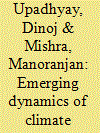

|
|
|
| 11 |
ID:
166398
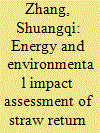

|
|
|
|
|
| Summary/Abstract |
The utilization of straw plays an important role in China's sustainable development. Returning straw to fields as organic fertilizer (straw return) and processing straw into straw briquette fuel (SBF) are two of the most promising methods for employing straw; however, there is a lack of information with respect to comparing these two methods. Therefore, a case study was conducted in Heilongjiang Province to estimate the energy and environmental impacts of straw return and the substitution of SBF for rural heating coal. This study aims to provide policymakers with useful information and to encourage rational decision-making regarding the efficient utilization of straw resources. Results showed that both straw return and substituting SBF for rural heating coal could have significant impacts on energy and the environment, while substituting SBF for rural heating coal had advantages over straw return in all aspects. Moreover, substituting SBF for rural heating coal was more acceptable to famers, and thus was easier to promote and could resolve the problem of open straw burning more effectively than straw return. Therefore, greater attention should be paid to SBF utilization, especially in rural areas. Results of this study can also benefit other regions to improve the utilization of straw resources.
|
|
|
|
|
|
|
|
|
|
|
|
|
|
|
|
| 12 |
ID:
110397
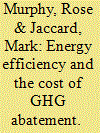

|
|
|
|
|
| Publication |
2011.
|
| Summary/Abstract |
A highly influential report by the McKinsey consulting firm suggests that a large potential for profitable energy efficiency exists in the US, and that substantial greenhouse gas emissions reductions can therefore be achieved at a low cost. This result is consistent with other studies conducted using a bottom-up methodology that dates back to the work of Lovins beginning in the 1970s. Research over the past two decades, however, has identified shortcomings with the conventional bottom-up approach, and this has led to the development of new analytical frameworks that are referred to as hybrid energy-economy models. Using the CIMS hybrid model, we conducted simulations for comparison with the McKinsey results. These exercises suggest a more modest potential to reduce greenhouse gas emissions at a given marginal cost, as well as a smaller contribution from energy efficiency relative to other abatement opportunities such as fuel switching and carbon capture and storage. Hybrid models incorporate parameters reflecting risk and quality into their estimates of technology costs, and our analysis suggests that these play a significant role in explaining differences in the results.
|
|
|
|
|
|
|
|
|
|
|
|
|
|
|
|
| 13 |
ID:
128728
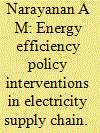

|
|
|
| 14 |
ID:
091516
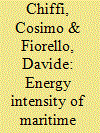

|
|
|
|
|
| Publication |
2009.
|
| Summary/Abstract |
This paper describes the energy consumption performance of sea-going ships engaged in the EU27 seaborne trades based on data and parameters resulting from the EX-TREMIS (EXploring non road TRansport EMISsions in Europe) database. EX-TREMIS is a comprehensive database of fleet and transport activity data, specific energy consumption, emission factors and total emissions from rail, maritime and air transport in the European Union. The EX-TREMIS maritime model derives from a mixture of top-down and bottom-up approaches for estimating pollutant emissions from shipping activities. The model did not use direct observations of actual trips, but empirically derived the number of equivalent-ships. Cargo type shipments were linked to seven ship type categories for which a further segmentation by ship size (three length classes), type and age of the main engine and type of fuel was applied.
|
|
|
|
|
|
|
|
|
|
|
|
|
|
|
|
| 15 |
ID:
118093
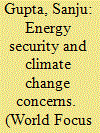

|
|
|
| 16 |
ID:
122753
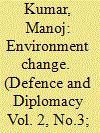

|
|
|
| 17 |
ID:
094872
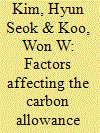

|
|
|
|
|
| Publication |
2010.
|
| Summary/Abstract |
The US carbon allowance market has different characteristic and price determination process from the EU ETS market, since emitting installations voluntarily participate in emission trading scheme. This paper examines factors affecting the US carbon allowance market. An autoregressive distributed lag model is used to examine the short- and long-run relationships between the US carbon allowance market and its determinant factors. In the long-run, the price of coal is a main factor in the determination of carbon allowance trading. In the short-run, on the other hand, the changes in crude oil and natural gas prices as well as coal price have significant effects on carbon allowance market
|
|
|
|
|
|
|
|
|
|
|
|
|
|
|
|
| 18 |
ID:
124624
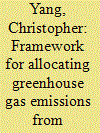

|
|
|
|
|
| Publication |
2013.
|
| Summary/Abstract |
This paper describes a number of different allocation methods for assigning greenhouse gas emissions from electricity generation to charging plug-in electric vehicles. These methods for calculating the carbon intensity of electricity are discussed in terms of merits and drawbacks and are placed into a framework to aid in understanding the relation with other allocation methods. Three independent decisions are used to define these methods (average vs. marginal, aggregate vs. temporally-explicit, and retrospective vs. prospective). This framework is important because the use of different methods can lead to very different carbon intensities and studies or analyses that do not properly identify the methods used can confuse policymakers and stakeholders, especially when compared to other studies using different methods.
|
|
|
|
|
|
|
|
|
|
|
|
|
|
|
|
| 19 |
ID:
088269


|
|
|
|
|
| Publication |
2009.
|
| Summary/Abstract |
Taiwan has drafted a Greenhouse Gas (GHG) Reduction Bill in 2006, which is currently undergoing the legislative process in the Congress. The purpose of this study is to reexamine the legal framework and contents of this Bill, evaluate potential problems and propose recommendations. This study advocates that setting the GHG reduction targets should be settled in this Bill. In addition, based on the analysis of international experiences, it is recommenced that emissions trading scheme in the Bill should be focused on large emission sources and the share of allowance auction should be increased to reduce gratis allocation. Furthermore, from the calculation results based on the long-range energy alternative planning (LEAP) model, a conflict is observed for the existing energy policy and GHG reduction efforts in Taiwan. That is, coal-burning power plants will be the most important source of energy for Taiwan in the future. In order to reduce this conflict, the authors have recommended that the Bill should also be integrated with other relevant existing legislation to achieve a complementary effect.
|
|
|
|
|
|
|
|
|
|
|
|
|
|
|
|
| 20 |
ID:
127521
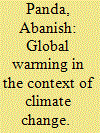

|
|
|
|
|
|
|
|